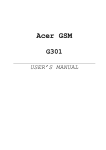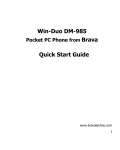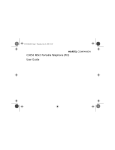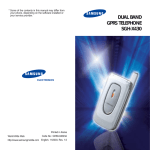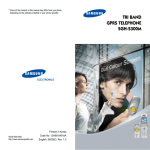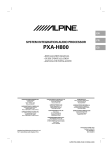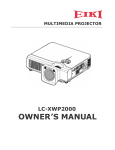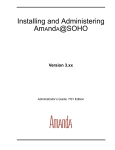Download COMPANION C3060 User guide
Transcript
C3060 Portable Telephone User Guide COMPANION Contents Getting started . . . . . . . . . . . . . . . . . . . . . . . . . . . . . . . . . . . . . . . . . . .5 Using your telephone directory . . . . . . . . . . . . . . . . . . . . . . . . . . . . .11 Using your services directory . . . . . . . . . . . . . . . . . . . . . . . . . . . . . . .15 Using your headset . . . . . . . . . . . . . . . . . . . . . . . . . . . . . . . . . . . . . . .19 Customizing your portable . . . . . . . . . . . . . . . . . . . . . . . . . . . . . . . . .21 Extra features . . . . . . . . . . . . . . . . . . . . . . . . . . . . . . . . . . . . . . . . . . . .25 Batteries and charging . . . . . . . . . . . . . . . . . . . . . . . . . . . . . . . . . . . .32 Accessories for your portable . . . . . . . . . . . . . . . . . . . . . . . . . . . . . .37 Safety information . . . . . . . . . . . . . . . . . . . . . . . . . . . . . . . . . . . . . . . .38 Technical specifications for USA . . . . . . . . . . . . . . . . . . . . . . . . . . . .41 Caring for your portable . . . . . . . . . . . . . . . . . . . . . . . . . . . . . . . . . . .43 Using your C3060 Portable with Meridian Companion . . . . . . . . . . . . . . . . . . . . . . . . . . . . . . . . . . . . . .45 Using your C3060 Portable with Companion 200 . . . . . . . . . . . . . . . . . . . . . . . . . . . . . . . . . . . . . . . . . . .51 Using your C3060 Portable with Norstar Companion . . . . . . . . . . . . . . . . . . . . . . . . . . . . . . . . . . . . . . .55 3 4 Getting started Before you use your portable for the first time, see Safety information on page 38. You should charge its battery pack overnight (See All about batteries and recharging on page 32). The parts of your portable Volume switch Softkeys Mute Directory Line Services Navigation keys Menu Power On/Off Release calls Terminate activity Headset /data connector 5 Turn the portable on Press and hold the k button for at least two seconds. Turn the portable off Press the k button for at least two seconds. Portable screen icons J,I,H,G Battery strength indicators (strong to very weak) Radio signal strength indicator (strong to very weak) p, Q, P Vibrator indicator V Note: The three buttons directly below your portable’s display are called softkeys. Their labels appear on the display with an underline above the button to which they are assigned. A softkey label is shown like this in this user guide: Setting your portable to ring 6 REDIAL. You can set your portable to one of three ring options by pressing the m button when the portable is idle. Select one of the softkeys for FULL, CHIRP, or NONE then press the OK softkey, or press the m button. FULL provides a normal ring volume and cadence. CHIRP provides one short ring at low volume. NONE provides no audible ring. Answering a call Press the i button. When the portable is ringing, you can press the m button to stop the ringing/vibration and continue to answer the call. Adjusting the ringing volume When the phone is ringing, you can adjust the ringing volume with the volume switch. When the phone is not ringing, use the Menu to access the volume adjustment levels. Adjusting the speaker volume While on a call, pressing b or B can adjust the volume in twelve steps. The steps 0 to 8 raise the volume, with step 0 the lowest volume. The steps 9 to 11 are for noisy environments. The display shows the volume step for two seconds as follows: • after adjusting the volume • before making or receiving a call at volume levels 9 to 11 7 . to increase volum e,press here to reduce volum e,press here Making a call Dial the telephone number directly or: • dial from your directory (See Using your telephone directory on page 11) • predial (See Customizing your portable on page 21) • press a customized softkey (See Customizing softkeys on page 30) Accessing features during a call You can access features or Computer Telephony Integration (CTI) applications while on a call, by three methods: 8 1. Press m, then select the appropriate softkey and dial the access code digits. 2. Select an entry from your Services directory. (See Using your services directory on page 15.) 3. Dial a feature from a programmable On-a-call softkey. (See To assign a number to a softkey when the portable is on a call on page 30.) Ending a call Press the k button. Making two calls in a row Press NEXT after your first call. The portable maintains its radio connection for another call. Keeping your connection To maintain your call, stay in the radio coverage area. If you have problems with your connection, retrace your steps. The signal strength icon Q indicates if the signal is becoming stronger or weaker. 9 Muting a call To prevent your caller from hearing you, press m on the left side of the portable. The display shows Microphone muted and then i in j flashes. To end muting, press m again. Redialing last number Your portable is set up so that you can redial the last number you dialed by pressing REDIAL when it appears. Dialing the last caller You can view the names of the last two callers when LAST appears on the display. Press LAST and , or . to view the names. Press > to view the number. Press DIAL to call the number or ERASE to delete the number. To add the name to the directory, press SAVE . 10 Using your telephone directory Your portable has an alphanumeric directory that allows you to store up to 100 entries for telephone numbers. Storing telephone directory entries 1. Press l, ADD. 2. Enter the telephone number, then press SAVE. 3. Enter the first letter of the name by pressing the button that has the letter you want. For example to enter A, press 2; to enter B, press 22. Use 1 to choose special characters such as , - ’ _ . ( ) 4. Enter the rest of the letters as shown in step 3. Use > to move the cursor forward if the next letter you want is on the same button, or select SPACE to insert a space. 5. When the name is complete, press SAVE. Hint: If you want an entry to appear at the start of your directory,m ake its first character a space using > or other special characters on the 1 key. 11 Find an entry in the telephone directory Once you have stored entries into the telephone directory, you can move through them quickly by pressing the first letter of the entry you want. For example to look for listings under D, press l, then 3; for listings under E, press l, then 33. If there is more than one entry under a letter, press . to keep looking. Note: Use 1 to choose special characters such as ,- ’ _ . ( ) Editing telephone directory entries 1. Press l, then . or , (or the first letter of the entry you want) until you reach the entry you want to change. Directory entries are in alphabetical order. 2. To edit the entry’s name press EDIT, then edit the name. 3. Press SAVE. 4. To edit the entry’s number press >, then press EDIT, then edit the number. 5. Press SAVE, k or press l. 12 Deleting an entry 1. Press l, then , or .. 2. Press ERASE. The display will ask Erase item? 3. Press OK. The display will show Item erased. (Select CANCEL if you do not want to erase the entry.) 4. Press k or l. Dialing from the telephone directory Press l, find the entry, DIAL. Pause and link signal When adding a directory item or customizing a softkey, you may need to insert a pause or a link signal. LINK or PAUSE appears when you are on a call to enable features such as Transfer and Conference. To insert a pause when you are predialing a number or storing it in your directory, press m and select Pause. The display shows P. 13 To insert a link signal, press m and select Link signal. The display shows L. (See Using your C3060 Portable with Meridian Companion or with Companion 200 or with Norstar Companion in this guide for using this feature.) 14 Using your services directory Your portable has a services directory that allows you to store up to 15 entries for feature codes and Computer Telephony Integration (CTI) applications. Note: Although the services directory can store telephone num bers, use the services directory for feature codes and CTI applications. If your system has a CTI server, double clicking the j button displays a pre-programmed menu of CTI applications. Note: The pre-program m ed m enu of CTI applications is only available on certain CTI system s. Storing services directory entries 15 1. Press j, ADD. 2. Enter the feature code or application code, then press SAVE. (See Using your C3060 Portable with Meridian Companion or with Companion 200 or with Norstar Companion in this guide for using this feature.) (See the your system administrator for feature codes to access CTI applications.) 3. Enter the first letter of the name by pressing the button that has the letter you want. For example to enter A, press 2; to enter B, press 22. 4. Enter the rest of the letters as shown in step 3. Use > to move the cursor forward if the next letter you want is on the same button, or select SPACE to insert a space. 5. When the name is complete, press SAVE. Hint: If you want an entry to appear at the start of your directory,m ake the directory entries first character a space using > or other special characters on the 1 key. Find an entry in the services directory Once you have stored entries into the services directory, you can move through them quickly by pressing the first letter of the entry you want. For example to look at listings under D, press j, then 3; for listings under E, press j, then 33. If there is more than one entry under a letter, press . to keep looking. Note: Use 1 to choose special characters such as ,- ’ _ . ( ) 16 Pause, link signal and feature request When adding a directory item, you may need to insert a pause, link or a feature request signal. You can use the feature request signal to enable CTI applications. Pause To insert a pause when you are predialing a number or storing a pause in your directory, press m and select Pause. The display shows P. Link signal To insert a link signal, press m and select Link signal or press Link if it is available. The display shows L. (See Using your C3060 Portable with Meridian Companion or with Companion 200 or with Norstar Companion in this guide for using this feature.) Feature request signal To insert a feature request signal, press m and select Feature request or press Feat if it is available. The display shows F. (See Using your C3060 Portable with Meridian Companion or with Companion 200 or with Norstar Companion in this guide for using this feature.) 17 Editing services directory entries 1. Press j, then find an entry. Directory entries are in alphabetical order. 2. To edit the entry’s name press EDIT, then edit the name. 3. Press SAVE. 4. To edit the entry’s number press >, then press EDIT. 5. Press SAVE, k. Deleting an entry 1. Press j, then find an entry. 2. Press ERASE. The display will ask Erase item? 3. Press OK. The display will show Item erased. (Select CANCEL if you do not want to erase the entry.) 4. Press k or j. Dialing from the services directory 18 Press j, find an entry, SELCT. Using your headset Use one of the optional headsets to free both hands for other tasks. Hint: Use the portable with a holster to protect the portable from falls. A holster also allows you free m ovem ent while you are on a call. Connecting and disconnecting the headset You can disconnect the headset during a call and the call remains on the portable. 19 Using your portable with the headset To answer a call, press i. To end a call, press k . Note: If you wear a hearing aid, use the C3002 headset to prevent unwanted tones in your hearing aid. Note: In noisy environm ents you can use the C3002 headset to provide better voice transm ission and reception. 20 Customizing your portable Hint: Whenever you are searching through a list,you can press the first letter of the feature,directory,or system entry you want. If there is m ore than one entry under a letter,press . to keep looking. To customize your portable, use the Menu, which contains a number of features in alphabetical order. Find a menu item To search through the available options on the Menu press m, , or .. Note: The portable displays options in several different ways. Whenever the display shows a heading followed by a colon,as in Vibrator: On,you can select the underlined softkey,OFF in this case,to switch to the other option. Whenever the display shows a heading followed by >,as in Language>,press > to enter a m enu of options which you can then m ove through by pressing , or .. 21 Key click 1. Select Key click:. 2. Choose ON to hear a short beep when you press a button. Keypad light Your portable’s keypad and display light for low-light conditions. The keypad and display lights independent of key pad light settings when the portable rings. 1. Select Keypad light:. 2. Choose ON to light the keypad when pressing a key. You can extend battery life by leaving the keypad light OFF when lighting is not required. Key-protect Key protect prevents accidently pressing the keys. 1. Select Key-protect:. 2. Choose ON or OFF . When Key-protect is turned on, press START to activate softkeys or buttons on the portable. Language 22 1. Select Language>. 2. Press >, then , or . to move between the In English and En français selections. 3. Press SELCT or SÉL, to select your choice. Last caller See Last caller on page 26. Line select To check that a number is correct before you dial, set up your portable for predialing. 1. Choose Line selct:. 2. Select MANUAL, k. 3. Enter the telephone number, which may be edited using BKSP. 4. Press i to dial your call or SAVE to store it in your directory. Note: You can insert a pause or a link into a predial sequence (See page 13). Long tones See Long tones on page 26. 23 Message service See Message Service on page 27 Program softkeys See Program softkeys on page 30 Ringer 1. Select Ringer:. 2. Press FULL for a normal ring volume and cadence. 3. Press CHIRP for one short ring at low volume. 4. Press NONE for no audible ring. Ring types 1. Select Ring types>. 2. Press >, , or . to hear samples. 3. Press SELCT to choose a new ring type, k. Ringer volume 1. Select Ringer volume>. 2. Press > , , or ., to hear samples or press a number from 1 to 5. 3. Press SELCT to choose a new ring volume, k. Vibrator 24 Select Vibrator:. The display shows V, and the portable vibrates briefly. Extra features Find a menu item To search through the available options on the Menu press m, , or .. Note: The portable displays options in several different ways. Whenever the display shows a heading followed by a colon,as in Vibrator: On,you can select the underlined softkey,OFF in this case,to switch to the other option. Whenever the display shows a heading followed by >,as in Language>,press > to enter a m enu of options which you can then m ove through by pressing , or .. If your system supports features such as Call Forward or Call Transfer, you can customize your Services directory to include them or you can assign them to a softkey (See Using your services directory on page 15, Customizing softkeys on page 30) and (See Using your C3060 Portable with Meridian Companion or with Companion 200 or with Norstar Companion in this guide for using this feature.) 25 You can put CTI feature codes, or system feature codes, or telephone numbers into your Services directory. Last caller If your system supports calling line ID, the last caller list shows the last two incoming calls. 1. Select Last caller:. 2. Press LAST to choose the last caller. 3. Press SAVE to save the last caller in the telephone directory. 4. Press ERASE to erase the last caller from the last caller list. 5. Press END to return to the idle display. Long tones 1. Select Long tones:. 2. Choose ON, k for long tones to respond to electronic banking services and telephone answering machines. This way you can send a tone that lasts until you take your finger off the button (up to 3 seconds). 26 Note: Not all system s support this feature. (See your system adm inistrator for features your system supports.) Message waiting Some systems allow your portable to display Message waiting if you have a voice mail message. Even if your system does not support Message Waiting indication, you can set up your portable with Message Service to dial directly into your voice mailbox. Message Service First, store a message service code. See To store your message service code on page 28. 1. Press MAIL to access the voice mail system. 2. Press PLAY to listen to the message and NEXT to move on to the next message. 3. Press PREV to listen to the previous message. 4. Press CALL to dial the number. Press DEL to delete the message. 5. Press END to exit your message service. 27 Note: If you press CALL ,and you want to use your active softkeys, press EXIT . Depending on your voice mail system, you may be required to change the dial codes. Dial codes are the numbers used to access voice mail system features. For example, the default dial code 76 deletes a message. If your voice mail system is Meridian Mail, you do not have to change the dial codes. If you change your message service code, you will have to change the dial codes as required. To store your message service code 1. Select Msg service #, CODE. 2. Enter ___________ (your voice mail service access number) and insert one or more pauses as required (See Pause and link signal page 13). 3. Enter __________ (your voice mailbox number and password) and press SAVE. Note: Your voice m ail system m ay require you to press # after you enter your m ailbox num ber or password. 28 4. The display shows Dialcodes? Note: Dialcodes? is only displayed after you first store the m essage service code. If you erase your m essage service code,you will have to go through dial codes again and change as required. Hint: For m ost Meridian Voice Mail system s,select DEFAULT. For Norstar Com panion system s that support integrated voice m ail,select NO. On som e Norstar Com panion system s,m essage service m ay work differently. (See your system adm inistrator for assistance.) 5. Press EDIT to change the default dial codes. Press DEFAULT when you do not want to change the dial codes. Press NO when you are not using dial codes. 6. Go through the dial codes and change the values for your voice mail system, if required. 29 Program softkeys For direct, one-touch access to frequently used features or frequently called numbers, customize your softkeys. You can program the softkeys for use when the portable is idle or is on a call. Softkeys not programmed keep their default values when the portable is idle or is on a call. The default idle softkeys are REDIAL, MAIL and LAST. The default on a call softkeys are NEXT, LINK and SAVE. To assign a number to a softkey for use when the portable is idle or on a call 1. Select Program softkeys. 2. Press the SELCT softkey. 3. Press the IDLE softkey to use the softkey when the portable is idle or press the On CALL softkey to use the softkey when the portable is on a call. 4. Press the SK - 1, SK - 2, or SK - 3 to select a softkey. 30 5. Enter a number at prompt Enter number, and SAVE. You can press m to access Pause, Link signal or Feature request. (See Pause, link signal and feature request on page 17.) 6. Enter a key label at prompt Enter key lable and SAVE. Label your softkey with up to four characters by pressing the button that has the letter you want. For example to enter A, press 2; to enter B, press 22. To return a customized softkey to the default setting 1. Select Program softkeys. 2. Press the SELCT softkey. 3. Press the On CALL or IDLE softkey. 4. Press the SK - 1, SK - 2, or SK - 3 to select the softkey you want to return to the default value. 5. Select new softkey to redefine another number and lable to the softkey. Or select REDIAL / MAIL / LAST / NEXT / LINK / SAVE to return the softkey to the default setting. 31 Batteries and charging Important battery information Before using your rechargeable battery pack for the first time, it must be charged for at least 8 hours. This is necessary to ensure full battery life. Do not leave your portable or battery pack on a battery charger for extended periods when the batteries are fully charged. Do not expose the battery packs to temperatures above 40°C/104°F for extended periods. Your portable needs a rechargeable battery pack. Battery level is shown by the J symbol on the top right of the display. If the batteries are very low, the display flashes G and you hear warning beeps. Your programming will not be lost if you replace your batteries. Preparing the chargers 32 Connect the ac adaptor plug of the power cable to the rear of the chargers, then attach the ac adaptor to a power source. Group Charger The Companion Group Charger accepts up to six battery packs for charging. Each slot has a LED indicator. Batteries are charged independent of position. For example, the first battery inserted is the first battery charged. Installing battery packs Insert the battery pack under the tab in the charger slot. 33 Individual Charger The Companion Individual Charger can charge a handset or a spare battery pack. To charge a separate battery pack in the desktop charger, you must place the battery pack under the tab in the desktop charger. You can store a spare battery pack in the rear slot of the battery charger. The rear slot is not a charging slot. 34 Note: All Com panion battery chargers will charge all Com panion battery packs. Except the Com panion C3050 Standard battery charger (A0628269/NTHH06BA) which will not charge the hi-cap (A0628217/NTHH04CA) batteries. Hint: In high usage environm ents it is a good idea to have a spare battery pack. Alternating the spare battery pack between charges will prolong battery life. Companion battery charger LED indications This table applies to the group and individual battery chargers. LED Red Indication Fast flashing Description Battery defective. Replace the battery Red Flashing Battery charging Yellow Flashing Testing or preparing battery for charging Green Steady Battery fully charged Off None Battery not inserted under the tab correctly 35 AAA batteries You can also use an optional AAA battery holder with your portable. Insert the batteries into the battery holder. Note: The com m ercially available AAA batteries cannot be charged in any Com panion battery charger. 36 Accessories for your portable The following accessories work with your C3060 portable: • C3001 Ear Bud Headset a sm all and lightweight ear-bud type headset • C3002 Over-the-head Headset a full over-the-head band for extra stability and hold with a single earpiece. • C3050 Clip-on Holster a custom -designed holster with an adjustable belt clip. • C3060 Leather Glove a leather glove that holds the portable with a plastic panel covering the keypad and display. • C3050 Rugged Protector a rubber protective case with a built-in rigid black plastic belt clip. The accessories listed here are available from your Nortel Networks distributor. 37 Safety information Electromagnetic energy safety Hazardous conditions can occur while operating a portable telephone near construction blasting caps or near emergency service radio receivers. Do not use this portable telephone in locations bearing warning signs that caution against radio transmission. Follow standard hospital acceptance procedures when using a portable near life-support systems. Battery safety Do not replace batteries in a hazardous environment (where sparks are considered dangerous, or where there are flammable gases, flammable liquids, dust, or flammable fumes). Do not attempt to charge alkaline batteries. Do not discard batteries in a fire. Batteries can explode when subjected to extremely high temperatures. 38 Do not place the portable where the battery charging contacts, on the bottom of the portable, will short out. For example, placing the portable in a pocket with loose coins. Charge the battery pack provided with the portable only in accordance with the instructions specified in this manual. Antenna safety The C3060 portable telephone emits low levels of radio energy. Although any risk associated with this energy is minimal, you can further minimize your exposure by not touching the antenna to your face while the portable telephone is turned on. Charger safety The C3060 charger power supply is an electrical device containing hazardous voltages. Do not open the power supply or the charger. Care when using earpiece Do not place the earpiece next to your ear if a foreign object has become attached to the earpeice. Note for hearing aid users Use of the portable telephone can produce an audible tone within a hearing aid. The C3002 headset can be used with hearing aids and will prevent the occurrence of the audible tone. 39 40 Technical specifications for USA Voltage 3.6 V rechargeable batteries 4.5 V (total voltage rating), three AAA alkaline batteries Frequency band 1.920 to 1.930 GHz Total channel capacity 99 Operating temperature 14°F to 104°F RF output power 32 mW ERP maximum 41 Regulatory compliance PCI CAI: FCC Etiquette This device complies with Part 15 of the FCC rules. Operation is subject to the following two conditions: 1). This device may not cause harmful interference, and 2). This device must accept any interference received, including interference that may cause undesired operation. Any changes or modifications applied to the portable telephone not expressly approved by Nortel could void the user’s authority to operate the equipment. Privacy 42 This portable telephone uses digital encoding to protect the speech transmission. Caring for your portable Temperature extremes Avoid subjecting the portable telephone to extremes in temperature. Care and maintenance Clean the portable telephone by wiping it with a damp cloth. Do not use solvents or polishes. If your portable telephone does not work, check all charging contacts on the portable and the charger for dirt, grease, or other material. If necessary, clean them with a soft dry cloth. If your portable drops into a liquid, let the portable dry for two days before using. Do not spray cleaning or disinfectant solutions on the portable. Spray the solution on a cloth and wipe the portable with the cloth. 43 Do not spray 44 Using your C3060 Portable with Meridian Companion This procedure describes steps to access several features of your portable telephone. Available features vary depending on your telephone system. Features Call Forward 1. Press i . 2. 3. 4. Enter ___________ (flexible feature code). Dial the number to which you want to forward your calls. Press k . Cancel Call Forward 1. Press i . 2. 3. 45 Enter ____________ (flexible feature code). Press k . Call Park 1. 2. 3. 4. While on a call, press LINK. Enter ____________ (flexible feature code). Enter ____________ (the number where you want to park the call). Press k to end the current call. Retrieve a parked call 1. 2. 3. Press i . Enter ____________ (flexible feature code). Enter the number to which the call was parked. Conference 1. 2. 3. While on a call with the first party, press LINK. Dial the second number. When your call is answered, press LINK. Transfer 1. 2. 3. 46 While on a call, press LINK. Dial the second number. When the second number rings, press k . Call Waiting While you are on a call, your portable beeps to indicate you have another call. 1. Press LINK to answer the second call. 2. Press LINK again to return to your previous call. Ring Again 1. 2. 3. 4. When you encounter a busy number, press LINK. Enter ____________ (flexible feature code). Press k . Your portable rings you back when a busy party is free. Press i . Your portable automatically places the call. Cancel Ring Again 1. Press i . 2. 3. Enter ____________ (flexible feature code). Press k . Speed Call 1. 2. Enter ____________ (flexible feature code). Enter ____________ (Speed Call code). System Speed Call 1. Enter ____________ (flexible feature code). 47 2. Enter ____________ (System Speed Call code). Add a link 1. Press m, , or .. 2. Select Link signal. The portable will display an L. Message Waiting Your portable displays Message waiting if you have a voice mail message. If you have already stored a message waiting code, you can access your messages by selecting CALL . (See page 27 for more information.) Switch from your portable to your desk telephone If Wireless Privacy is enabled • Use Call Transfer. • Use Conference. If Wireless Privacy is disabled • Use your portable as an extension telephone. Troubleshooting checklist 1. 2. 48 Battery charged? Properly placed? Call Forward canceled? 3. Still having trouble? Call your system administrator. Other frequently used Feature Codes: Contact for your system: Nam e: Tel #: 49 Troubleshooting checklist 50 Using your C3060 Portable with Companion 200 This procedure describes steps to access several features of your portable telephone. Available features vary depending on your telephone system. Features Call Forward 1. 2. 3. 4. Press i . Enter ___________ (Call Forward code). Dial the number to which you want to forward your calls. You may need to wait for a tone. Press k . Cancel Call Forward 1. 2. 51 Press i . Enter ___________ (Cancel Call Forward code). You may need to wait for a tone. 3. Press k . Call Park 1. 2. 3. While on a call, press LINK. Enter ________ (Call Park code). Press k . Retrieve a parked call 1. 2. 3. Press i . Enter ___________ (Call Park Retrieval code). Enter the number to which the call was parked. Conference 1. 2. 3. While on a call with the first party, press LINK. Dial the second number. When your call is answered, press LINK. Transfer 1. 2. 3. 52 While on a call, press LINK. Dial the second number. When your call is answered, press k . Switch from your portable telephone to your desk telephone: Troubleshooting checklist 1. 2. 3. Battery charged? Properly placed? Call Forward canceled? Still having trouble? Call your system administrator. Other frequently used Feature Codes: 53 Contact for your system: Nam e: Tel #: 54 Using your C3060 Portable with Norstar Companion This procedure describes steps to access several features of your portable. Note: Underlined text indicates a softkey to use below the display of the C3060 portable. Making an internal call 1. Dial the number (you may have to press i to select a line). Making an external call 1. 2. 55 Dial external access code: ________ or enter a line pool code (provided by your installer): ________. (You may have to press i to select a line.) Dial the number. Features Transferring using a number 1. While on a call, press LINK. 2. 3. Dial a second internal number. When call is answered, press k . Transferring using the directory 1. While on a call, press LINK. 2. Press l. 3. Use , or . or enter a letter to search through the list of 4. 5. entries. Press DIAL when you have made a selection. When call is answered, press k . Using Conference 1. 2. 3. While on a call with the first party, press LINK. Dial a second internal number. When it is answered, press LINK again. Switching between two calls While on a call you will hear a beep to indicate an incoming call (call 56 waiting tone). 1. Answer a second incoming call by pressing LINK. The first caller is put on hold. 2. When you are ready to switch to the other caller, press LINK. Page 1. Press FEAT 60 or *60 . The display shows Page choice:. 2. 3. To page specific speakers, press SPKR. or To page telephone extensions, press SETS . or To page speakers and extensions, press BOTH. The display shows Enter zone:. Enter the page zone (1 to 6) on the keypad or press ALL. Note: For systems earlier than MICS-XC 2.0, Page can only be used if an ATA is configured. To page telephone extensions on systems earlier than MICS-XC 2.0: 1. Press i and enter the line pool code associated with the ATA. 57 2. 3. Press LINK and enter FEAT 71 or *71. Enter the page feature code to use followed by a page zone number (0 to 6). Language selection You can change the language for system messages. (See the Quick Reference Table for features that use system messages.) 1. To select English for system messages, press FEAT 501 or *501. 2. To select French for system messages, press FEAT 502 or *502. 3. To select Spanish for system messages, press FEAT 503 or *503. To change the portable telephone language: 1. Press m and select Language>. 2. Press >, then , or . to move between the In English and the En français selections. 3. Press SELCT or SÉL to select your choice. Quick Reference Table You may have to press i to select a line to activate some of the following features. 58 Enter the feature code you want to use. Feature Activation Code Call Forward FEAT 4 or *4 Cancel Call Forward FEAT #4 or *#4 During a call press LINK + FEAT 74 Call Park* Call Park (retrieve)* Call Pickup - directed† Call Pickup - group† System Speed Dial or *74 The portable then displays the call park location Press LINK and enter the call park location. This is only required when you are on a call. FEAT 76 or *76 + extension number FEAT 75 or *75 FEAT 0 or *0 + two digit Speed Dial code Trunk Answer from any FEAT 800 or station *800 Voice Mail retrieval FEAT 981 or *981 59 Feature Activation Code Query Voice Mail DN *985 Leave VM Message *980 Intercept Voice Mail *987 FEAT 985 or FEAT 980 or FEAT 987 or * These features require MICS-XC 2.0 or later telephone system software. † These features require MICS-XC 3.0 or later telephone system software. The use of the FEAT softkey requires MICS-XC 4.1 or later telephone system software. Portable telephone hints • The softkeys on your C3060 portable operate differently than on your Norstar desk telephone. Some C3060 portable softkeys work with the local features described in this guide. 60 • Norstar Voice Mail operates by means of your C3060 portable’s softkeys during voice mail sessions in MICSXC 2.0 systems or later. Troubleshooting checklist • Batteries charged? • Batteries properly placed? • Still problems? Call your system administrator. Contact for your system: Nam e: Tel #: 61 Troubleshooting checklist 62 E Printed on recycled paper Copyright © 1999 Nortel Networks All rights reserved. Meridian,Norstar and Com panion are tradem arks of Nortel Networks Corporation. P0906702 Issue 1.00 Printed in Canada For m ore inform ation,visit the Com panion hom epage at http://www.nortel.com /com panion
































































